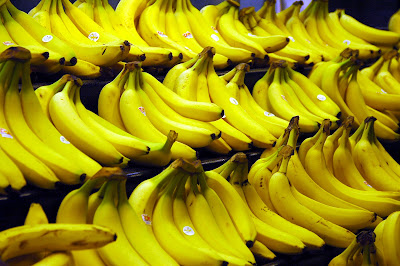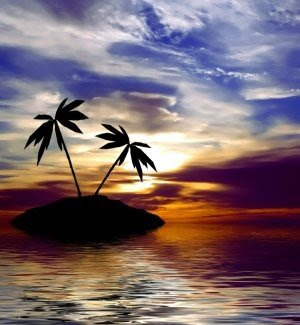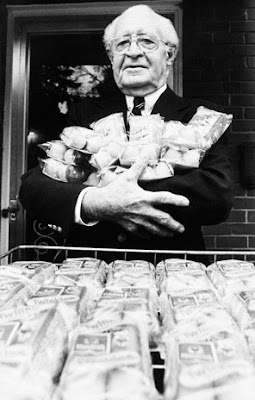Bananas have an interesting history. Some horticulturalists believe that the banana was the Earth's first "fruit." Actually, the banana is not a fruit, it is an herb.They are believed to have originated in Southeast Asia before recorded history (5,000-8,000 B.C.). They spread throughout the rest of Asia and Oceania. Alexander the Great and his army encountered bananas when they invaded India in 327 B.C..
 |
| So common now, bananas were unknown in the ancient Mediterranean world. |
NOTE:
The forbidden fruit of the Tree of Knowledge in the Garden
of Eden is popularly thought to be an apple. Historians have said it was more likely a banana or some other fruit native to the Arabian/Persian Gulf/East African region. Apples did not exist in that place at that time. Question: Shouldn't it be called an "Adam's banana" rather than an "Adam's apple"?
of Eden is popularly thought to be an apple. Historians have said it was more likely a banana or some other fruit native to the Arabian/Persian Gulf/East African region. Apples did not exist in that place at that time. Question: Shouldn't it be called an "Adam's banana" rather than an "Adam's apple"?
BACK TO BANANAS:
The continent of Africa produces, presently, more bananas (they are most commonly called "plantains," a kind of cooking banana) than any other, but you will never see a banana from Africa in a food store because they are consumed entirely by that continent’s people. It cannot afford to export a major source of nutrition for its population.
 |
| Plantains at an African marketplace. |
 |
| Fried plantain over rice. |
Banana shoots were introduced into the New World by Spanish colonists in 1516 on the island of Hispaniola (the Caribbean island containing the countries of Haiti and the Dominican Republic). This was one small part of what historians have come to refer to as the "Columbian Exchange" : the exchange of foods, plants, languages, diseases, etc...between the New World and Europe. (For more on this see my posts on Christopher Columbus, November 23, 2011, and the discovery of cocoa beans and Montezuma's "golden goblet," September 20, 2011.)
 |
| Bananas ready to be harvested. |
The first banana in England was seen at the shop of herbalist (remember, the banana is not a fruit but an herb!) Thomas Johnson in 1633. It came from the New World island of Bermuda. Bananas were used as an ingredient in herbal medicine. Scientifically, we now know that bananas have large amounts of vitamins, complex carbohydrates and potassium. They are also an excellent source of fiber.
 |
| Marooned on a desert island? What could you survive on? |
Some nutritional experts have said that if you were to be marooned on a desert island with no access to water, you could live indefinitely on bananas. It is the only food for which this is true.
NOTE:
The only European nation to grow bananas commercially is Iceland, on soil heated by geysers. It's true! Also, they grow bananas in Greece, but not as a commercial crop. |
| Bananas growing in Iceland in geothermally heated soil. |
 |
| A guidebook sold at the Centennial Exhibition in Philadelphia in 1876 would have directed you to an exhibition hall where banana trees were being displayed. (See next picture.) |
Bananas were not regularly available in the U.S. until after W.W.I when refrigeration was installed in many ocean-going vessels. Today, Americans eat more bananas than any other fruit (remember, though, it's really an herb), followed by apples in second place, and grapes in third.
 |
| A specialized, refrigerated Dole Company ocean-going vessel (it's even colored like a banana) delivering bananas to the U.S. market. |
There are over 140 edible species of bananas, but those sold in stores are only 2 or 3 kinds of the many grown. Only those who live in “banana country” ever get to sample the many different varieties. Let's indulge in a musical interlude having to do with bananas. Here are The Muppets performing the famous/familiar song "Yes, We Have No Bananas." Just for fun.
Question: Can you name the most famous banana in history?Well, here she (yes, it's a female banana) is. Enjoy her performance. She sure sold a lot of bananas during her commercial life. She was created and produced by the United Fruit Company during the late 1940s and became a recognizable brand logo for decades on both TV and radio. This is the original commercial.
This is a later TV commercial featuring Chiquita and her banana song.
DIGRESSION:
In 1931 a man named James Dewar was the manager of the Continental Baking Company's Chicago, Illinois, factory. He had a problem. The company had thousands of shortcake pans that were heavily used during the spring months to produce the shortcakes used to make strawberry shortcake, strawberries being a spring crop. For the rest of the year these pans sat unused. Mr. Dewar was trying to figure out a way to utilize these pans for the remainder of the year. He came up with the idea of producing, during the rest of the year, a shortcake-like product with a filling to make it a special taste treat. He decided on a banana-cream filling, and decided to market it as a low priced snack to sell during the Depression.
 |
| James Dewar with his new snack food invention. |
This treat was originally called "Little Shortcake Fingers" but on a car trip to St. Louis, Missouri, with a business partner Dewar noticed a sign for a shoe factory advertising that it was the home of "Twinkle Toe Shoes." Dewar had been looking for a more catchy title for his new product. His business partner suggested the name "Twinkle Fingers" but Dewar thought he had a better idea. He decided to name his product, simply, "Twinkies." Junk food history had just been made. This new snack food was priced at 5 cents and contained two Twinkies, one for yourself and one for a friend (if you didn't want them both yourself).
 |
| 1930s ad for 5 cent Twinkies. One for yourself, one for a friend. |
This 5 cent snack soon became one of the Continental Baking Company's best-selling products. However, a historical event had a profound effect on the recipe use to make Twinkies. With the advent of WW II, a banana shortage hit the U.S. All ships were devoted to the military effort required to defeat the Axis powers (Germany, Italy, Japan). Importing bananas was not a priority, and it was a rare thing to see a banana in the U.S. during the war years.
 |
| All ships were used for the war effort. No ships were available to import bananas for making Twinkies. They were not a priority. |
Thus, the Continental baking company made the decision to change the filling for its Twinkies to a vanilla cream. Vanilla was more accessible as an ingredient and the change was made. It went over very well and vanilla cream filling has remained the norm in Twinkies ever since. This is one of the lesser known effects of WW II on American culinary history.
In short, for better or worse, it has become an American icon. It was advertised in print, on the radio and, in the 1950s and later, on TV. Here are two examples:
"Buffalo Bob" Smith doing a Twinkie commercial on the
"Howdy Doody Show," 1950s.
1970s Twinkies TV commercial keying in on the interest
in the space program and moon landings of the period.
in the space program and moon landings of the period.
FUN FACTS ABOUT "TWINKIES":
1) Twinkies have a shelf life of 25 days. The secret to their
longevity is that they lack some dairy ingredients
usually used in baking.
2) Hostess estimates that they use 8 million pounds of sugar,
7 million pounds of flour, and 1 million eggs to produce the
500 million Twinkies made each year. If you want
to know, that comes out to be about 1,000
Twinkies a minute or 16 a second.
3) It takes 45 seconds to explode a Twinkie in a microwave.
4) It takes 40,000 miles of plastic wrap a year to package all
the Twinkies made. At 150 calorie apiece, all those
Twinkies have the energy equivalent to nearly
51,500 barrels of crude oil.
5) Before he died in 1985 James Dewar said that Twinkies
were"...the best darn tootin' idea I ever had." He said
that the key to his long life (he lived to the age of 88)
was to "...eat Twinkies every day and smoke a pack of
cigarettes."
6) The deep fried Twinkie may be the most significant event in recent Twinkie history. Here is a You Tube video review of a deep-fried Twinkie recipe, with chocolate no less! Try this and/or fry this at your own risk!!!
LAST BUT NOT LEAST: TWO ITEMS
First, I discovered this new food product while doing my "research" on this post. Here's a picture. It's almost too difficult to believe. But if it can be done, someone is going to do it.
I leave it to you. Good idea? Or,...??
I could see this as a deep fried beef twinkie.
What do you think?
Second, in a throwback to its origins, the Twinkie has recently been reintroduced with a banana cream filling. It is being marketed as a "NEW" item, but it is simply a return to its original recipe.
 |
| "New"? Hardly. Perhaps it could have been marketed as "The Original Twinkie." What do you think? |
END OF DIGRESSION.
So there it is, the connection between the history of the banana and the Hostess Twinkie: the switch from the banana cream filling to a vanilla cream filling during WW II. Maybe it's a stretch, but it all makes sense to me in my own non-linear world. And what about the old gag about someone slipping on a discarded banana peel. This stunt has gotten laughs in old silent films, on TV and in numerous cartoons. Here is a You Tube video demonstrating this stunt:
NOTE:
Actually, slipping on a banana peel is not as infrequent or "far out" as you may imagine. In 2001 in Great Britain there were more than 300 banana-related accidents, most of them involving people slipping on banana skins and falling.
FINISHING UP:
Harry Belafonte sang a song during the 1950s called "The Banana Boat Song." that was a huge hit. The meaning of the song went over most people's heads, however. The song did popularize Caribbean and Calypso music in the U.S., but the words of the song referred to the history of slavery in the Caribbean, and were a humanitarian appeal for tolerance and understanding. Harry Belafonte himself was passionate in his outspoken appeals for social justice. Here he appears on the Muppet Show (I know, it just turned out this way!) singing this serious song with the humorous assistance of Jim Henson's Muppet crew. Bananas! Bananas! Bananas!
NOTE:
The phrase "going bananas", referring to someone who goes out of control or gets crazy, comes from monkeys in the zoo who become upset, hysterical or severely disturbed when they do not receive their daily allotment of bananas. Other sources, such as The Oxford English Dictionary (which claims to have been the first to "officially" record the term), state that the phrase results, simply, from the fruit's comic connection to monkeys (again, it's an herb, not a fruit). Take your pick.
 |
| NOT "going bananas." |
 |
| "GOING BANANAS." |
FUN FACTS ABOUT BANANAS:
1) There are more than 500 varieties of bananas in the world. As I mentioned earlier, only about 140 of these
varieties are edible.
varieties are edible.
2) Banana plants are the largest plants on earth without a woody stem. They are actually giant herbs of the
same family as lilies, orchids and palms.
same family as lilies, orchids and palms.
3) The English word "banana" comes from the Arabic word "banan" which means finger.
4) As bananas ripen, the starch in the fruit turns to sugar. Therefore, the riper the banana the sweeter
it will taste.
it will taste.
5) In Eastern Africa you can buy banana beer. The beer is brewed from bananas.
East African beer made with bananas.
6) India is by far the world's largest producer of bananas, producing more than twice as many bananas (approx. 18 million tons) as its nearest competitor, Brazil (approx. 8 million tons).
7) We typically think of bananas as being yellow but they actually come in a variety of colors including purple and red.
WELL, THAT'S ALL FOR NOW.
PLEASE VISIT AGAIN!
PLEASE VISIT AGAIN!




